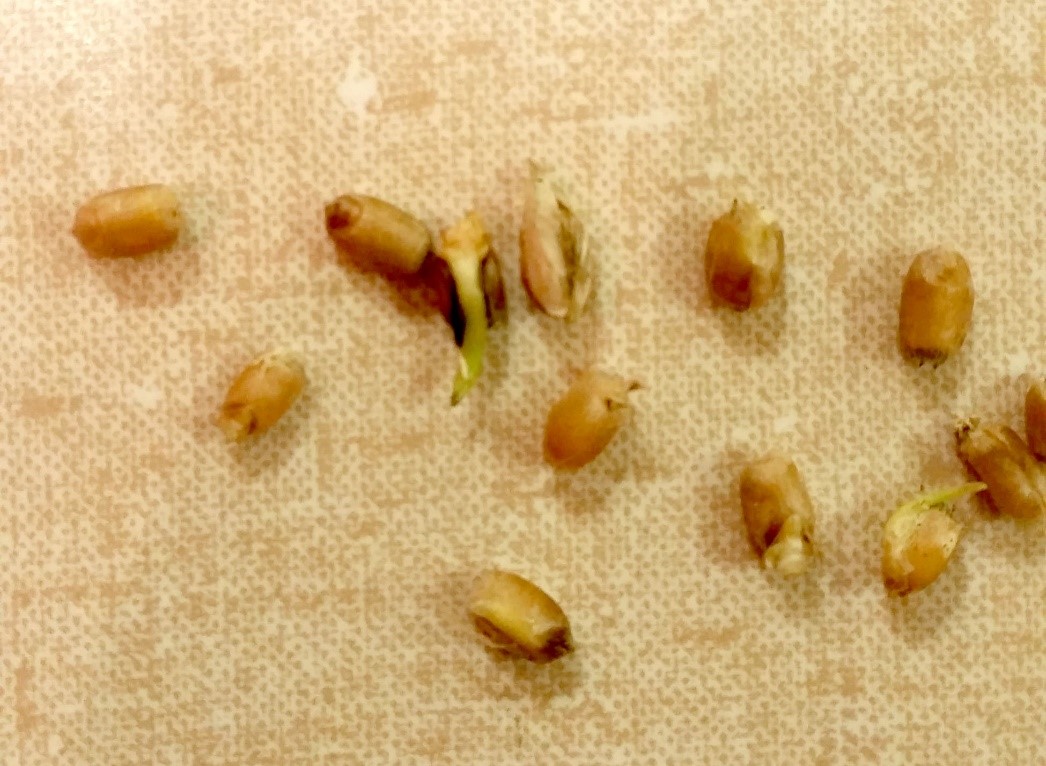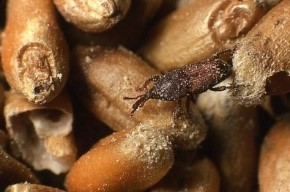Concerns with Sprouted Wheat in Storage
The excessive rain during the final weeks of harvest are raising concerns about storing sprouted wheat kernels. What are some concerns with storing this wheat and what can be done with sprouted wheat?
 |
Sprouted wheat kernels (Texas A&M AgriLife Extension Service photo) |
Wheat with a moisture content of more than 12.5% will be at risk in storage regardless of test weight, sprouting, or quality. The higher the moisture content, the higher the risk. Please note that the moisture content of sprouted grain is actually 1.0 to 1.5% higher than the grain moisture meter indicates. Moist grain also increases the chance of having mold, mustiness, odor, and insect damage. High moisture content in wheat must be reduced as quickly as possible to ensure successful storage.
One way to reduce the moisture content of stored grain is with aeration.
During summer aeration, 0.5% moisture can be removed from 12% grain during one cooling cycle. A cooling cycle is the amount of time required to cool the grain mass from one temperature to another. Bins with areation fans producing 1/10 cfm/bu may require as much as 150 hours of fan operation to complete one cooling cycle if the grain in the bin is level. More time is required if the grain mass is peaked. More information about aeration for stored grain is available in Fact Sheets BAE-1102 and BAE-1103.
If aeration is not available, turn the grain mass to mix layers of moist and drier grain. Coring the bin, by pulling the center core of grain out of the bin using the unload spout or hopper conveyer which removes much of the fine material, improves distribution of air during aeration.
Insect management for short-term storage of sprouted wheat should not be an issue. However, long-term storage of high moisture grain can lead to a significant reduction in grain quality. Certain stored grain insects, such as the rice weevil which causes insect damaged kernels (IDK), must have grain that is at least 12.5% moisture or higher to survive. Therefore, if your grain is moist, additional insect species may attack your grain during storage. Rice weevils will not be found in drier grain. It is critical to pay attention to potential insect activity throughout the storage period to keep the grain at high quality. Having good quality grain at the time of market will only happen if regular insect monitoring occurs.
 |
Rice weevil (Photo by Edmond Bonjour) |
Spouted wheat in storage facilities respires at a higher rate than dry grain and the oxygen is converted to carbon dioxide. This can create a safety hazard for workers entering the storage facility. Check for low oxygen or high carbon dioxide levels using appropriate detectors. Operating aeration fans for 30-60 minutes prior to entering a bin will bring in fresh air and reduce the chance of a hazardous situation.
Sprout-damaged grain can be used in livestock rations. If mold is present, aflatoxin screening needs to be conducted. If the toxin is not present, the sprouted wheat can be used in cattle rations. In general, when feeding sprouted wheat to ruminant livestock:
- Limit wheat to 40% or less of the total ration
- Bring cattle to full feed at a slower rate – avoid self-feeding
- Process wheat coarsely to improve digestibility
- Do not use wheat in creep ration
When feeding sprouted wheat to swine:
- Balance diets containing wheat on a lysine basis
- Process wheat-based diets coarsely to reduce dust and increase palatability
- If vomitoxins are present, do not feed to swine
Wheat which has sprouted also effects the falling number which is important in bread making. The falling number in wheat flour expresses the time in seconds for a stirring rod in a falling number apparatus to sink through the starch paste. The falling number in sound, non-sprouted wheat is from 350 to more than 500 seconds, while falling numbers from less than 350 down to less than 100 seconds are an indicator for the sprouting of wheat. Too low a falling number renders the flour too poor to be used for bread making.
Additional information can be found in OSU Extension Fact Sheet BAE-1109, Storage and Use of Low Test Weight and Sprouted Wheat.
